October 8, 2007 at 8:08 pm · Filed under Places to go
One of the great things about traveling with Bert & Janie is that they bring us to places we’d be unlikely to visit otherwise. Case in point: Bannack, Montana. It’s so far off the beaten path and not on the way to much that we probably would have passed it by.
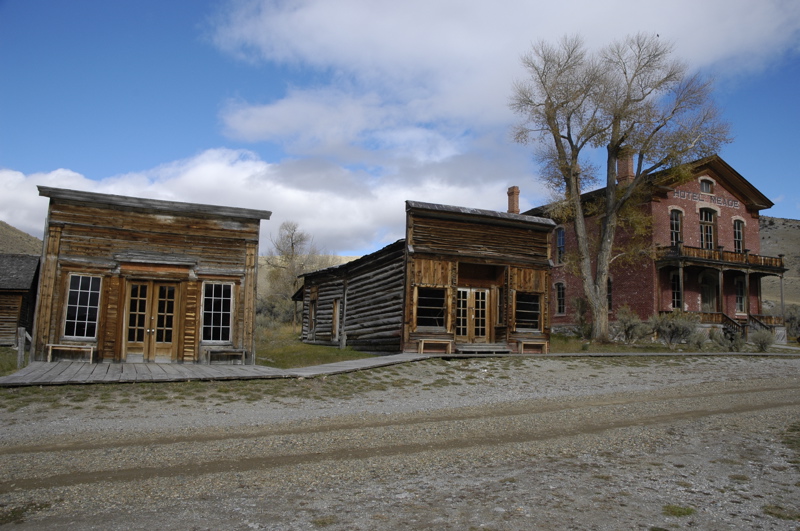
Bannack is a ghost town, the best I’ve ever seen. Once a gold rush town and the territorial capital of Montana, it has managed to escape becoming either a tourist trap like Tombstone AZ or a collection of dried-up ruins like so many Nevada settlements. The state made it a state park and thus Bannack is preserved and free from commercial inflammation.
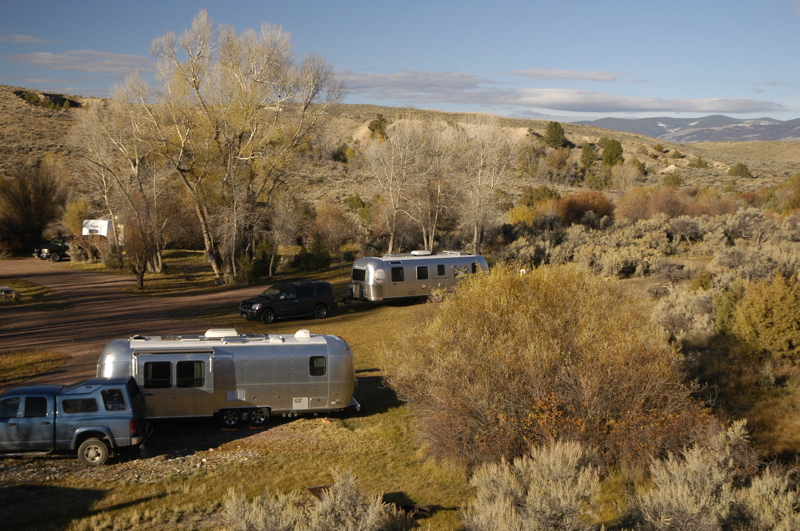
For RV’ers, Bannack is an excellent stop because there are two small and tranquil state park campgrounds a short 1/4 mile walk from the townsite. These campgrounds are small, and border Grasshopper Creek (more on that in a moment). The sites are grassy and open, occasionally shaded by cottonwood trees, and have a expansive view of the surrounding mountains. There are no hookups, no cell phone service, no amenities of any kind, and no dump station, but for $10 ($6 for Montana seniors) it’s well worth a stay.
WordPress (the new blog software we’re using now) does not allow me to upload the Google Earth placemarks that I used to insert into the blog from time to time. But here’s the Lat/Long for the campground we visited in Bannack State Park: 45 ° 9’54.12″N, 113 ° 0’16.66″W. You can plug that into Google Earth (or any other mapping program) and see the location. The ghost town is just east of the campground.
Two days before in Virginia City I bought a book by Dorothy M Johnson called “The Bloody Bozeman.” It’s about the creation and history of the Bozeman Trail. The book starts in the historical epicenter of Montana in 1862 — Bannack — and describes not only the gold rush that started on the banks of the Grasshopper Creek and resulted in the founding of Bannack, but the surrounding stories of battles with the Sioux Indians, survival in the western wilderness, and the marauding “Road Agents” who operated between Bannack and Virginia City.
There’s nothing like reading these tales while I’m camped in the exact spot where they happened. It’s spooky enough to walk through the open dirt street of Bannack and look at all the empty buildings … but quite a bit spookier to have the stories of John Bozeman and Red Bear, Jim Bridger and “Clubfoot” George Ives fresh in my mind as I see the land where they once rode, shot, and died.

Up the hill from town is the gallows. It’s not much to see — a simple arrangement of poles, like field goal. But on the short hike up, you can imagine you’re going up to witness the hanging of Henry Plummer, leader of a gang of road agents, who said when finally caught and arrested that he was “too evil to die.” On the gallows high on the hill above Bannack, Plummer asked for one last favor: “Give me a good drop” so that he would die quickly.
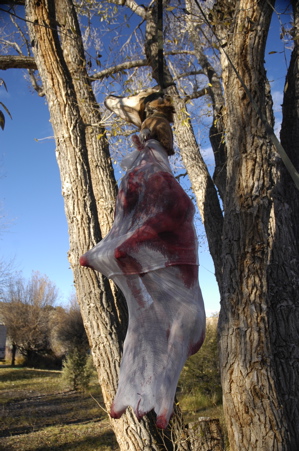
This is antelope season. Although hunting isn’t allowed in the state park, many of our neighbors in the campground seem to be hunters who use the park as a base of operations. In the evening the results of one successful hunt were seen swinging from a tree next to our campsite … an eery reminder of the men who swung from the gallows just a quarter-mile away.
In the evening Emma challenged Bert to a game of checkers. No slouch at checkers or chess, Bert gave her a run for her money and eventually defeated her. I think perhaps my threat to mention in the blog that he was beaten by a 7-year-old put him on his best game. Then Emma challenged me and beat me handily due to my failure to see two double-jumps coming.
Tonight we are on our own up, about 90 minutes north, near Butte. Bert & Janie have gone on ahead to their home in northern Montana, and we’ve stopped at Fairmont Hot Springs Resort to have a swim in their hot water pools. The resort has giant indoor and outdoor pools (two each, running 92-94 and 102-104 degrees), and a huge five-story tall water slide. After all the cold weather we’ve seen lately, this seemed like the right stop to make.
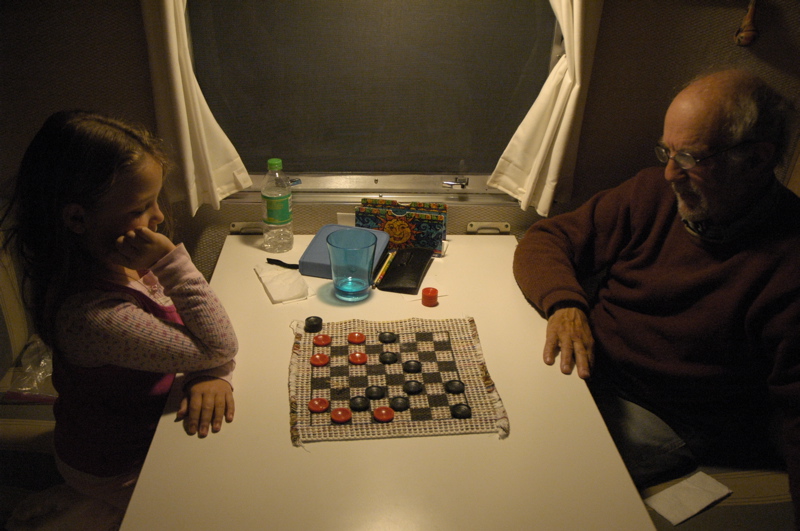
Fairmont Hot Springs RV Resort: 46 ° 2’31.89″N, 112 °48’23.77″W.
October 6, 2007 at 10:07 pm · Filed under Uncategorized
The winter storm that has brought us the constant rain and snow the past two days was still with us this morning. Even in Ennis, below 5000 ft, we woke up to snow flurries and threatening gray skies.
We debated all morning about the choice between another visit to Virginia City, or driving 59 miles to Bozeman to see the Museum of the Rockies (which was highly recommended). In the end, Bert & Janie went back to Virginia City and we took the beautiful but snowy route east to Bozeman.
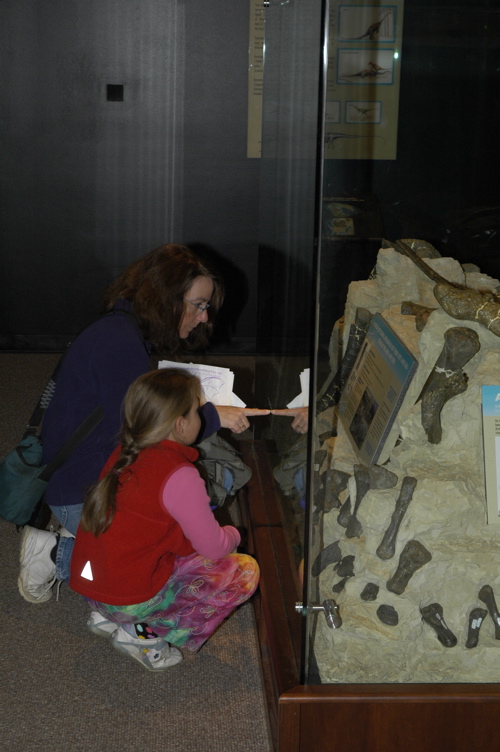 The Museum of the Rockies is adjacent to Montana State University, and it was highly recommended to us for the dinosaur exhibit. Emma is at that age when dinosaurs are cooler than chocolate ice pops, so even though we saw dinos just a couple of weeks ago in Thermopolis, we had to go.
The Museum of the Rockies is adjacent to Montana State University, and it was highly recommended to us for the dinosaur exhibit. Emma is at that age when dinosaurs are cooler than chocolate ice pops, so even though we saw dinos just a couple of weeks ago in Thermopolis, we had to go.
Of course, what Emma doesn’t know is that every museum is an opportunity for homeschooling. She just soaks it up like kids do, and then spouts it back to anyone who will listen. Sometimes adults are a little taken aback when they hear her talking about the Cretaceous Period and what an Archaeopteryx looked like. (“Gee, they don’t have any feathered dinosaurs in this brochure, and those are the ones I know the best!”)
Montana has a “Dinosaur Trail” which has 16 places to stop (museums, parks, and field stations) in a giant circle across the state. We’ll get nowhere near all of those sites, but I’ve asked Bert to research and write a dinosaur-hunting article for one of the 2008 or 2009 issues of Airstream Life magazine. His article will include not only the great spots in Montana but also those in Wyoming, South Dakota, Colorado, and possibly Utah.
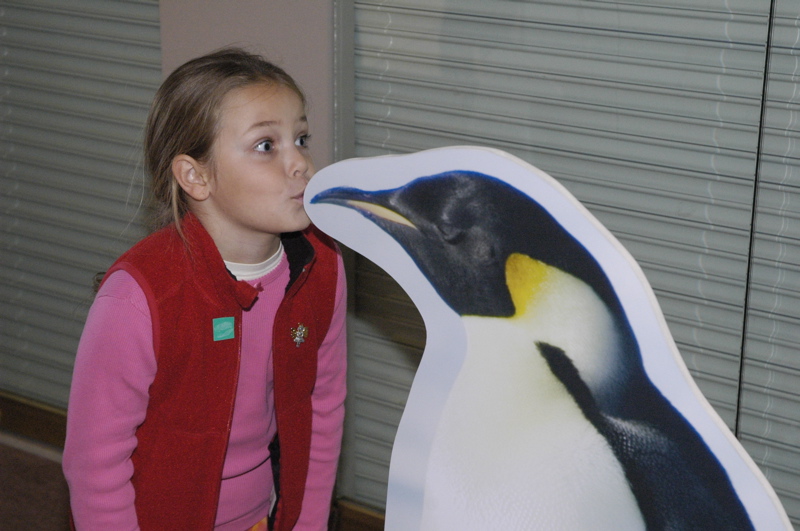
The storm began to move off to the southeast in the afternoon, which gave us views of the mountains that we hadn’t been able to see before. With the heavy clouds and fog, it was easy to forget that we’re in the northern reaches of the Rocky Mountains. Being in a valley between two ranges of mountains, Ennis has some spectacular views both east and west, and with the dissipating fog and golden fields it became quite dramatic.

Mountains over Ennis Lake Recreation Area. Click for larger.
The town is cute and very small, amounting to a two-block downtown. But everything is there, including a cafe where you can hear the local news being discussed in the morning, and a creaky old-time one-screen theater across the street. Being Saturday night, we decided to check both out. (We left Bert & Janie back at the campground — those poor folks are just too old to go out on a Saturday night, I guess.)
 Emma has had quite a good day by kid standards (see her blog entry, following), and the parents have too, so I didn’t see any reason to stop the fun this evening. Besides, it has been forever since I saw a movie in an a really old-fashioned theater with Art Deco lighting, a balcony, and cracked leather seats with wooden backs. About 25 local kids showed up to see the movie with us. The theater is only open Friday and Saturday nights, and the movie changes every week. I got the sense that someone was keeping the theater alive against financial logic, because it was a good thing for the community. Or perhaps, it does a more lively business in the summer. In any case, it was nice to find.
Emma has had quite a good day by kid standards (see her blog entry, following), and the parents have too, so I didn’t see any reason to stop the fun this evening. Besides, it has been forever since I saw a movie in an a really old-fashioned theater with Art Deco lighting, a balcony, and cracked leather seats with wooden backs. About 25 local kids showed up to see the movie with us. The theater is only open Friday and Saturday nights, and the movie changes every week. I got the sense that someone was keeping the theater alive against financial logic, because it was a good thing for the community. Or perhaps, it does a more lively business in the summer. In any case, it was nice to find.
We like small downtowns like this one. There’s a strong sense of community and a central gathering point for people, and a little bit of nightlife. One thing I never liked about living in rural areas was the sense of isolation that comes from lacking a town center. I think this affects our choice of places to travel. While many people dream of finding that perfect secluded spot and camping “away from it all”, we have seclusion available to us in abundance and so tend to seek out places where people live and commune.
But tomorrow we will definitely be out in the boonies. We are heading to Bannack, a true western ghost town where it is likely I will not be able to get online. If so, I’ll update the blog from our stop on Monday.
By the way, I uploaded a bunch of pictures from our trip to Yellowstone National Park. You can see them in our Flickr photo album.
October 6, 2007 at 9:46 pm · Filed under Emma's posts
- Playing in the snow

- Gameboy in the car
- Dinosaur museum
- IHOP for lunch
- Milkshake
- Popcorn
- Movie (“Mr Bean’s Holiday”)
October 5, 2007 at 7:14 pm · Filed under Places to go
For the next few days we’ll be following Bert & Janie as they research a few spots in Montana for articles they are working on. One of the articles is actually for Airstream Life magazine’s Summer 2008 issue, about things to see and do in Montana. I’m kind of shooting photos over Bert’s shoulder, in hopes of spotting a sidebar I can write to go with his article.
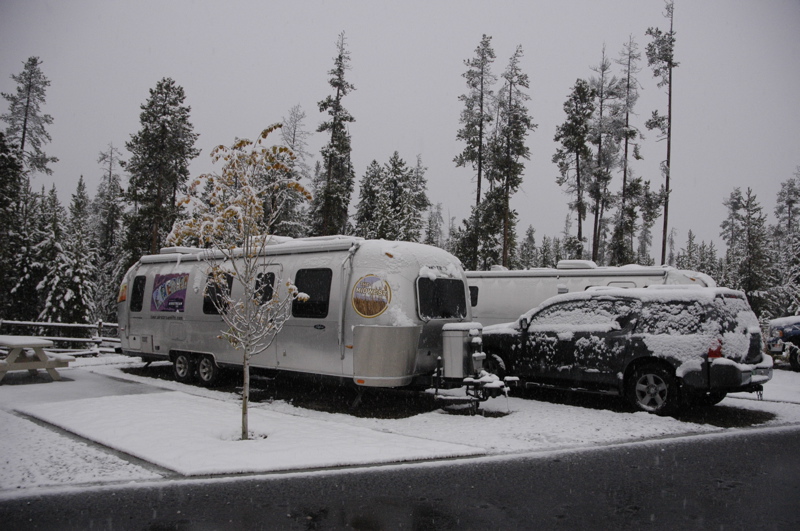
Morning in West Yellowstone, MT
As predicted, the rain last night turned to snow, and we woke up to about two inches of very wet snow. It makes great scenery and Emma loves it, but it also makes the process of breaking camp a lot slower. I keep a junky beach towel in the back of the Armada just for wiping stuff clean, and the towel got used a lot this morning to dry off things like the power cord.
With all the cold weather and snow I have to remind myself that it’s just early October. It seems like December in Vermont. The ride up into the mountains on Rt 87 and Rt 287 from West Yellowstone was stunningly beautiful at times, especially near Quake Lake, but it was just as nice to descend a little down to the relatively low town of Ennis MT and see the snow deliquesce into light rain and green grass. I would have been much more nervous about this drive if the roads were frozen, but it’s still early enough in the season that ice on the roadways is unlikely.
We are using Ennis as a base camp for the next two nights, while we make explorations into the nearby famous western town of Virginia City. (Virginia City does have a good RV park but there’s no cell phone service there and I wanted to be in touch over the weekend.) It’s 14 miles up and over some mountains to find Virginia City and the historic remains of Nevada City as well.

Boot Hill, resting place of several “road agents”
Virginia City is a true western town, perhaps the quintessential western town, and it is loaded with good examples of preserved architecture and lots of gory history. The museum, for example, includes the foot of “Clubfoot” George, but I’ll talk about that tomorrow when we go see it. Tons of westerns have been filmed in Virginia City or the nearby remains of Nevada City. There’s an amazing amount of preserved history here and it’s all fun to discover.
With the weather still fairly lousy today (light rain & snow, fog), we decided to save the intense browsing of Virginia City for Saturday. We found an old pub in town and settled in for a long lunch and some conversation with the proprietors.
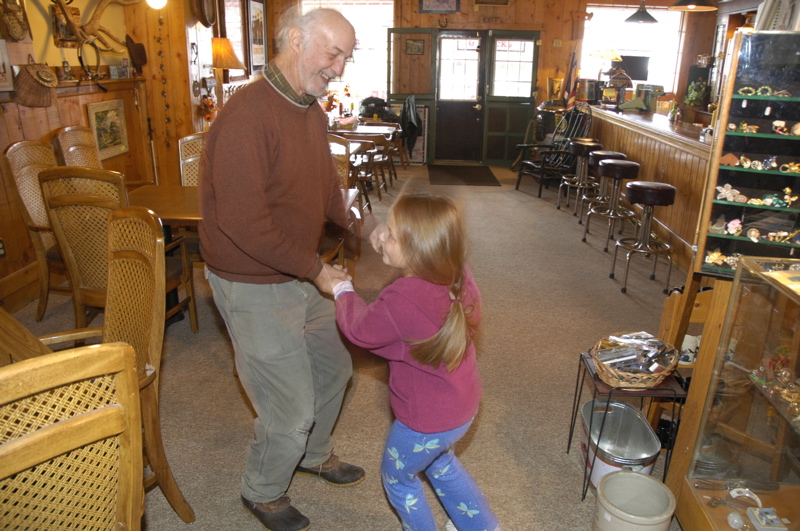
Inside they were playing old big band favorites, and at one point Bert invited Emma to dance. Since we were the only customers all afternoon, the management didn’t mind our tourist antics.
Nevada City, just a mile or two down the road, is really not a town at all anymore. There were about eight original buildings remaining in the 1940s, but then others were collected from all over Montana to create a preservation site of old western rustic architecture. Now there are dozens of buildings assembled into a sort of museum, which you can tour for about eight bucks. This time of year, of course, the place is closed but there’s still a lot to be seen from the street.
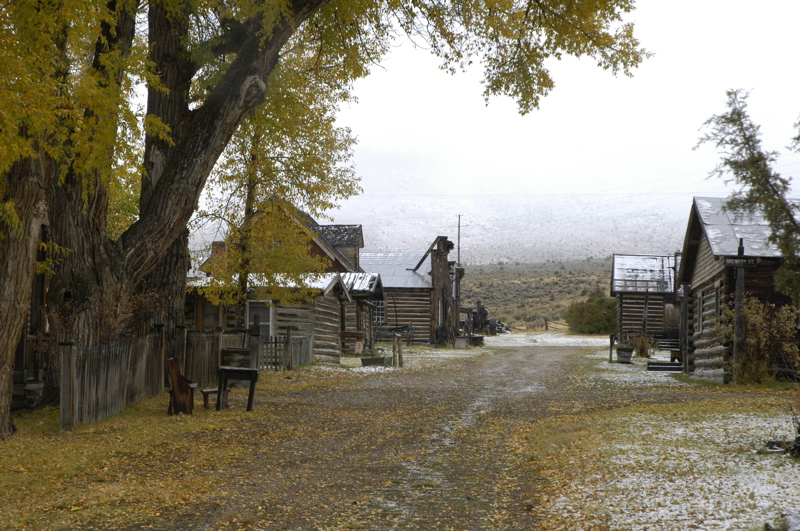
Nevada City, MT
We’ll be touring ghost towns and preserved gold mining towns for the next few days. I’m also working on plans for a visit to Banff, Alberta. The weather in Banff is potentially tricky but this time of year we have a chance of being able to get up there, as long as we watch for snowstorms. Our arrival there is still a week away, so we’ll keep an eye on things and see if it remains a possibility.
October 4, 2007 at 8:53 pm · Filed under Uncategorized
A cold light rain is pattering on the aluminum roof tonight. It’ll probably turn to snow in a few hours. We’ve been disconnecting the water line at night and switching to the onboard fresh water tank because of the freezing temperatures.
 This morning it was partly cloudy, and West Yellowstone warmed up into the low 50s. This constantly changing weather is expected to continue for a few days, but it hasn’t really impeded us. This morning Bert and I headed back into the park to a marshy spot about eight miles north of Norris where he’d seen a cow moose and calf yesterday. The grass was wet and covered with light snow and branches, hard for us to navigate, but it was exactly the type of marshy, protected area that moose love, so we figured she’d still be around somewhere.
This morning it was partly cloudy, and West Yellowstone warmed up into the low 50s. This constantly changing weather is expected to continue for a few days, but it hasn’t really impeded us. This morning Bert and I headed back into the park to a marshy spot about eight miles north of Norris where he’d seen a cow moose and calf yesterday. The grass was wet and covered with light snow and branches, hard for us to navigate, but it was exactly the type of marshy, protected area that moose love, so we figured she’d still be around somewhere.
As with the Great Gray Owl Hunt, we struck out on finding the moose, but still managed to have a great time. We slogged past muddy moose tracks and forded a small stream, climbed over downed trees and came out covered in wet debris. Bert was mightily disappointed about the mystery of the missing moose and yet we were both glad we’d come out to Yellowstone for another hike. It’s hard to get tired of the place.
Up the road we found some spectacular views of Electric Peak and Sheepeater Cliff, along with Roaring Mountain. A bit further south we dropped in on Norris Geyser Basin and toured a piece of it that I hadn’t seen last week with Eleanor and Emma. Bert and I kept saying to each other, “Yellowstone is just an amazing place!” He’s been here many more times than I, and yet he’s still amazed with it, so I know we’ll enjoy another visit someday.




Today is our last day in the area, so in the late afternoon we all went into town to walk the center of town and see the historic buildings in West Yellowstone. I hadn’t even noticed the collection of old Union Pacific Railway buildings that line Yellowstone Street, nor the little fragment of the original rail line built in 1907 that still remains. But the local Chamber of Commerce has a brochure that describes all the buildings and does a fine job of explaining how West Yellowstone came to be.

The town has always been a terminus of the railroad. It was originally a collection of buildings on land leases in the Madison National Forest, until Woodrow Wilson signed the land over and the town was officially established in 1920. You’d ride the summertime-only “Yellowstone Special” up from Idaho and then hire a stage ride into the park. It was pretty expensive for those days. A stage ride from Norris to Canyon (about 14 miles by today’s roads) was $5.00 in 1915, about equal to $102 in today’s dollars.
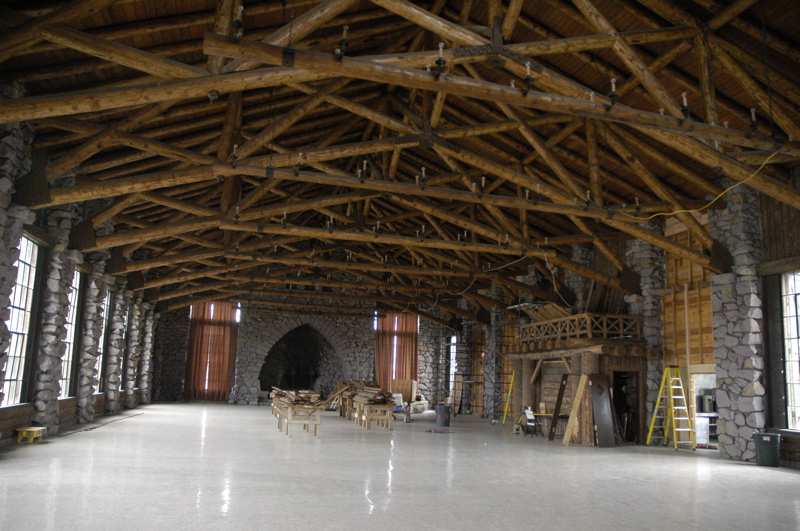
Now the railway buildings still stand, even though the railroad was abandoned in 1977 (passenger service ended in the 1960s). The huge and elaborate timber dining hall is on the National Historic Register and is currently undergoing renovation. The depot is now the Yellowstone Museum. The baggage building is now the police station. All of them still have the rustic timber-and-stone construction that predates the quasi-Adirondack “national park rustic” style that was popularized in later decades.
I gathered another professional opinion about our battery charging situation. The advice was to replace the Parallax completely with an Intellipower unit, which has a better reputation for reliability and will also offer 3-stage charging. It’s not a direct-fit replacement, but the cost of the swap is similar to the cost of upgrading the Parallax, so I’m considering that option as well. We can also get a unit that incorporates a true-sine wave inverter suitable for the laser printer (for a lot more money), which I’ll consider but probably won’t do.
October 3, 2007 at 10:07 pm · Filed under Mobile technology, Tips & Ideas
Our admission to the Grizzly and Wolf Discover Center was a two-day ticket, so Emma went back on Tuesday afternoon to join a special kids program. They let the kids go into the bear habitat (when the bears aren’t there, of course) and hide food under the rocks and stumps for the bears to find. This is great fun for the kids and the grizzlies. The kids get to “feed the bears” in a safe and legal fashion, and the grizzlies get to go sniff it out, which keeps their lives interesting.

Sam the grizzly bear says “Go ahead, leave some food at your campsite!”
Recovering from a long period offline is serious work. There are the usual emails and phone calls to be caught up on, and replenishing our supplies, and it all tends to happen in a big hurry because we want to be able to do more stuff as soon as possible. So today I spent about 12 hours parked in front of the computer while Emma finished her latest Junior Ranger projects (two of them, for two different Yellowstone patches) and Eleanor dealt with heaps of laundry.
This evening I emerged from the trailer at sunset and found Bert preparing to go into town for a tank of propane, so I put my empty 30# propane tank in his truck and joined him for the ride.
West Yellowstone is a very small town concentrated in about six square blocks at the gate of Yellowstone National Park. It has the look of an Alaskan village, with shabby buildings that show the wear of long hard winters, randomly intermingled with well-kept shops aimed at the tourist trade, and restaurants that sport neon signs. There are three gas stations in two blocks distance, a sign that this is the outpost of Yellowstone and the next gas station is a long way off.
This time of year West Yellowstone is shutting down. The tourists are mostly gone, the skies have gone gray, and the sun is setting before 7 p.m. We counted ourselves lucky to find a place still selling propane after 6 p.m. (a corner convenience store). Bert mentioned this to one of the locals, who snorted, “Are you kidding? West Yellowstone!” as if “West Yellowstone” was a self-explanatory expletive, a code word for avarice or commercialism.
“Not while there’s money to be made,” he went on, but I think his attitude was too vehement to be fair to the town. Yes, it caters to the tourist trade — why else would it be here? — but looking around I can see that the people who make a living here do so at the price of a long winter. I can’t begrudge them trying to make a living during the few short months of summertime activity.
Our campground is more than half empty. I’m sure most of the people who are still here are commuting into Yellowstone, as Bert did today. He was hunting again for the Great Gray Owl, but found a female moose and calf instead. We are seriously considering going back into the park tomorrow together to try for some good photos of the moose, but we’ll need to book another night here first.
I have discovered something annoying about the factory power converter. Our trailer has a Parallax 7300 series converter. It contains a 2-stage battery charger, which means it’s the thing responsible for setting the rate of charge of our batteries when we plug in.
We came out of Yellowstone with our batteries drained about 125 amp-hours and I expected that we’d be re-charged in a day or so. But the Parallax only rapid-charged the batteries for a couple of hours. After that, based on the voltage of the batteries, it stepped down to its “trickle-charge” rate, even though the batteries were still about 70 amp-hours from full.
Since then it has charged at a pathetically slow rate, between 0.37 amps and 1.5 amps. (Our Tri-Metric 2020 system monitor tells us this.) This means our batteries will take days to fully recharge. If we relied on the very basic monitor that comes with nearly all RVs, we’d think we were recharged because a silly little (inaccurate) telltale light would glow green, but the Tri-Metric actually knows better and it tells us the truth.
I’ve been asking for opinions on how to improve this situation from RV electrical system experts, and so far the explanation is that I need to upgrade the Parallax to a 3-stage charger, which is possible but costs over $200 just for the necessary parts. With a third stage that charges at a higher voltage, the Parallax will be much more effective.
Interestingly, we already have a separate 3-stage charge controller in the Airstream (a Blue Sky SolarBoost 2000e) specifically for the solar panels. The Blue Sky unit takes over when sun starts to hit the solar panels. So when the sun comes out, our rate of charge increases dramatically, up as high as 10 amps (actual amperage depends on the amount of sun), and when the sun goes behind a cloud we’re back to the trickle charge level determined by the Parallax. In other words, we can charge much more quickly using a little sunshine than we can when plugged into a 30-amp power cord!
The past few 36 hours have not been very sunny, which (as Dr Seuss would say) seems rather unfunny. We are plugged into all the electrical power we could want, enough to run a heat pump and toaster, but the stupid power converter won’t let our batteries have any!
One partial solution to this quandary is to reduce our power requirements in the future. As several correspondents have pointed out to me, a catalytic heater would eliminate the need to run the energy-robbing furnace and thus reduce our cold-weather power needs by more than half. I agree, and I wish we’d installed a catalytic heater a year ago when I first considered it. We had cat heaters in our previous two Airstreams and loved them for their efficiency and quietness.
For now I am going to take a week or two to consider what to do. Both options presented so far (upgrading the Parallax and adding a catalytic heater) will cost $300-400 each by the time we are done. Also, we are heading into a rather hectic travel period and don’t foresee any long stops for at least several weeks, which makes pausing for service a problem.
I think the immediate thing to do is to go look for moose in Yellowstone while I’ve still got the chance. I’ll get up early in the morning to finalize some work and join Bert for one last photo safari. I can worry about the power situation later.
One final note: this evening Bert, Janie, and I were talking about all the places we’ve met and camped together. We came up with nine states we’ve met in: Maine, Vermont, New Jersey, Florida, Texas, New Mexico, Arizona, Wyoming, and Montana. I love the fact that we are long-distance friends and yet manage to get together for good camping fun all over the country.
October 2, 2007 at 7:12 pm · Filed under Mobile technology, Tips & Ideas
We are back in touch with the world, and I have backdated several blog entries from our trip to Yellowstone. Scroll down to see all the new entries (since September 27).
Last night’s gentle rain turned into freezing rain and then snow, so that this morning when I opened the curtains I found the world outside completely changed from fall to winter with about a half-inch of snow. The balmy sunny weather of just a few days ago seems far off now, with the nearby mountains shrouded in fog and a definite Christmas-y feel to the air.

Our entry step was completely coated in ice when I went out, and I found Bert standing at his awning looking at a heap of snow and ice that had coated it and distorted the fabric. He had put his awning out the day before to protect his generator from the rain, but hadn’t anticipated that the rain would become ice.
Like us, Bert and Janie were planning to leave Madison campground today. They were headed off to Grand Teton’s last open campground (Signal Mountain) to find some moose. But first, they had to figure out how to remove inches of snow and ice from their awning and their slide-out. We ended up beating on the ice and sweeping repeatedly, while waiting for the temperature to rise above freezing. Eventually enough was removed for him to roll up the awning and go, but it was far from clean and dry.
I had the same problem with the folding bicycle I’d left cabled to the hitch overnight, but it was easier to de-ice. I hauled it into the Airstream and let it melt on a towel for an hour.

Yellowstone is just as beautiful in the snow as it was last week in the sun. The meadows glow gold when struck by the light, and the broad flat rivers still glisten and burble and sprout fly-fishermen in hip waders. The mountains are draped with cloud and the bison are coated with frost on their dark woolly manes.
It all works so well that I almost began to despair at the excess of photographic opportunities. There simply wasn’t enough time, even in six days and nights, to begin to capture this place. I shot over eight hundred photographs (culled to about 400 hundred at this point, and still going). It wasn’t enough.

Steaming hot water pours down from Grand Prismatic Geyser into the Firehole River
We came out of the six-night “no-hookup” camping experience in Yellowstone surprisingly well. Despite trees shading our solar panels, freezing temperatures every night, and a few cloudy days, we emerged with this final status:
28 degrees at 8:00 a.m. Snow on panels. -133 amp-hours cumulative (50 amp-hours used overnight)
That’s not bad at all. As I noted when we left Cody, our safe useful battery power is 150 amp-hours (out of 300 total in the bank), and even after six nights we didn’t hit our limit. The key was serious conservation, primarily by keeping the furnace set low at night. We settled on 50 degrees as our overnight setting, which wasn’t bad at all with a lot of blankets on the beds. Bert and Janie set theirs at 40 degrees and sleep in sleeping bags. This morning we met a fellow in a fifth wheel who says his insulation is virtually non-existent and so they just turn off the furnace at night. Compared to them, we are total weenies.
Water-wise we did even better. Our 39-gallon fresh water tank was still about 1/3 full when we left. We took a total of six showers between us (with minor sponge baths from the sink between showers), used the bathroom at night, and did a few dishes when we didn’t feel like going out to the campground sink. It was really great to test our ability to camp on minimal resources, like the old days when we were tenting, and know what our Airstream can do.
Some of you may be reading this and thinking, “How horrible — sponge baths, a cold trailer, no TV,” but really it’s fun. It’s a game to see how long we can stretch a gallon of water, how long we can make a battery last, and how well we can keep ourselves entertained in a place with relatively few of the modern distractions.
After six nights it was time to go find a place to replenish our supplies. We’re now in a commercial campground in the little town of West Yellowstone MT, just a half mile from the park gate. This place has what we need for the next few days: electrical power, stores, cell phone service, Internet, propane. I’m going to sit down before my computer and get some progress on the layouts for the upcoming Winter 2007 magazine, and we’ll also re-stock for a few more days of boondocking in Montana next week.
Bert & Janie got skunked on their plan to head down to Grand Teton. The snow last night caused road closures heading south, and they were forced back north. They also heard from Eric and Sue that the moose were being elusive. So now they’re here, parked right next to us for the next two days, doing the same things we are. Well, except for one thing: Bert had to open his awning up again to melt the last of the ice that got rolled up in it this morning. Now it looks normal again.
Once we’re all caught up, the plan is to head up to some ghost towns in Montana, but I’ll tell you about that later.
« Previous entries ·
Next entries »


























